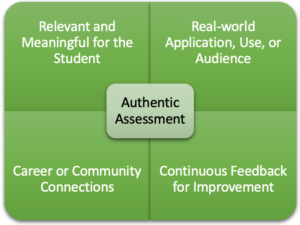Assessments are meant to measure whether a learner has reached or is making progress toward learning outcomes or competencies. Authentic forms of assessment do this while preparing students to apply what they learn beyond the classroom, whether that's in the workplace or their community. In addition, authentic assessments are more likely to increase student engagement as students can see such tasks as being about more than a grade.
Aspects of authentic assessment
Real-world application

Consider how what is being learned is used by people in your discipline beyond academia. Remember, most undergraduate students leave academia after earning their bachelor's degree.
Under what circumstances outside of academia might students use the mathematics principle you taught last week? What about the business concept or anatomy fact? How might learners apply the historical or geological facts they'll learn about this term?
Continuous feedback
Just as with other types of assessments, students need to receive feedback throughout their learning process when engaging in authentic assessment. This feedback should come at points that allow students to learn from it and improve during the class term. Formative feedback, which is low stakes and usually carries no marks, can come from instructors, teaching assistants, peers, and through student reflection.
Community connection
Assessments that involve engaging with the community or industry create opportunities for learners to apply what they've learned in a "real-world" context. See more on experiential learning and open pedagogy for more information, ideas, and examples of such projects.
Relevance for learners
Finally, assessments that show how the learning can be applied beyond academia to support student goals or address community and global problems students are concerned with increase student engagement.
Real-world applications and community connections of the facts, skills, and concepts learned related to climate change, economic and gender inequality, ethnic and religious conflict, and other problems students are worried about, allow learners to feel like they are working toward change and not simply a grade.
Get support
For support or a consultation on this topic, reach out to the team at the Gwenna Moss Centre for Teaching and Learning.

